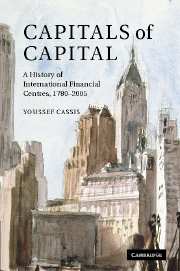Book contents
- Frontmatter
- Contents
- List of tables
- Foreword
- Preface
- Introduction
- 1 The age of private bankers, 1780–1840
- 2 The concentration of capital, 1840–1875
- 3 A globalised world, 1875–1914
- 4 Wars and depression, 1914–1945
- 5 Growth and regulation, 1945–1980
- 6 Globalisation, innovation and crisis, 1980–2009
- Conclusion
- Glossary
- Notes
- Bibliography
- Index
3 - A globalised world, 1875–1914
Published online by Cambridge University Press: 05 June 2012
- Frontmatter
- Contents
- List of tables
- Foreword
- Preface
- Introduction
- 1 The age of private bankers, 1780–1840
- 2 The concentration of capital, 1840–1875
- 3 A globalised world, 1875–1914
- 4 Wars and depression, 1914–1945
- 5 Growth and regulation, 1945–1980
- 6 Globalisation, innovation and crisis, 1980–2009
- Conclusion
- Glossary
- Notes
- Bibliography
- Index
Summary
Globalised economy or age of empires? To ask the question is to highlight, from the very outset, the ambiguous nature of the globalisation of the world economy during the three or four decades before the First World War. Opening up the world – with the revolution in transport and communications, population shifts and the free circulation of capital – went hand in hand with establishing colonial empires and with the imperialist powers extending direct or indirect domination over most of the world on an unprecedented scale. In 1914 the British Empire stretched over 30 million square km and included 450 million inhabitants, while the French colonial empire stretched over ten million square km with 50 million inhabitants. On top of this, they informally held sway over regions as vast as China, the Ottoman Empire and Latin America. These two phenomena are only partly linked, yet they are not completely unconnected either – as revealed by arguments among contemporaries, as well as among generations of historians, about the primacy of politics or of economics in spreading imperialism at the end of the nineteenth century. But in either case, the international financial centres were more involved in opening up the world than in colonial imperialism.
Whatever one's viewpoint, the political and economic environment prior to 1914 was particularly conducive to the rapid development of international financial centres. In many respects, it was truly a golden age for them and one that they would not encounter again before the late twentieth century.
- Type
- Chapter
- Information
- Capitals of CapitalA History of International Financial Centres 1780–2005, pp. 74 - 142Publisher: Cambridge University PressPrint publication year: 2006



